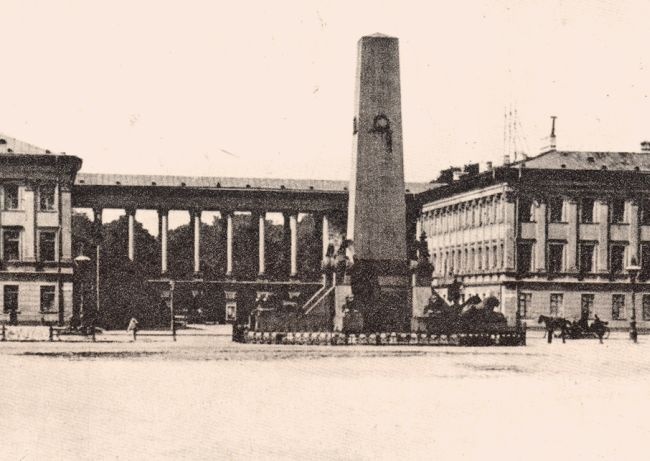Post by Bonobo on May 13, 2016 22:32:52 GMT 1
The November Uprising (1830–31), Polish–Russian War 1830–31,[3] also known as the Cadet Revolution, was an armed rebellion in the heartland of partitioned Poland against the Russian Empire. The uprising began on 29 November 1830 in Warsaw when the young Polish officers from the local Army of the Congress Poland's military academy revolted, led by lieutenant Piotr Wysocki. They were soon joined by large segments of societies of Lithuania, Belarus, and the right-bank of Ukraine. Despite local successes, the uprising was eventually crushed by a numerically superior Imperial Russian Army under Ivan Paskevich.[4][5][6] Czar Nicholas I decreed that henceforth Poland was an integral part of Russia, with Warsaw little more than a military garrison, its university closed.[7]
The armed struggle began when a group of conspirators led by a young cadet from the Warsaw officers' school, Piotr Wysocki, took arms from their garrison on 29 November 1830 and attacked the Belweder Palace, the main seat of the Grand Duke. The final spark that ignited Warsaw was a Russian plan to use the Polish Army to suppress France's July Revolution and the Belgian Revolution, in clear violation of the Polish constitution. The rebels managed to enter the Belweder, but Grand Duke Constantine had escaped in women's clothing. The rebels then turned to the main city arsenal, capturing it after a brief struggle. The following day, armed Polish civilians forced the Russian troops to withdraw north of Warsaw. This incident is sometimes called the Warsaw Uprising or the November Night. (Polish: Noc listopadowa).
During the first hours of the Rising, cadets roamed the streets and gathered supporters. They ran into several of their high rank officers and asked them to take the lead of the revolt. 6 officers refused and were shot on the spot, one died by mistake. The Russian tsar, after crushing the Rising, ordered a monument to be raised in honour to those who had remained loyal.
E.g.,
en.wikipedia.org/wiki/John_Maurice_Hauke
In the uprising of 1830 led by revolutionary army cadets, the target was Grand Duke Constantine, Poland's Governor-General. Count Moritz Hauke was on his way to the Grand Duke who managed to escape, but Hauke was shot to death by the cadets on the street of Warsaw before the eyes of his wife, Sophie Lafontaine, and his three younger children. He was riding on a horse beside the carriage of his wife and having met a group of rebels who shouted "Be our leader, General!" Hauke reprimanded them and told them to go back to their quarters, whereupon they opened fire and killed him. His wife died shortly afterwards, and their younger children were made wards of the Tsar, while three elder sons joined the uprising and one of them, Maurice Leopold, fell during the battle of Ostrołęka in 1831 only 27 years old. After his victory over the Poles, the Tsar raised in 1841 an enormous obelisque in Warsaw, which was dedicated to the memory of Hauke and five other Polish generals who "preserved their fidelity to their Monarch". Detested by the inhabitants of the Polish capital, the obelisque was pulled down in 1917.





A malicious rhyme created by Warsawians: 8 lions and 4 birds watch over 7 villains.
The armed struggle began when a group of conspirators led by a young cadet from the Warsaw officers' school, Piotr Wysocki, took arms from their garrison on 29 November 1830 and attacked the Belweder Palace, the main seat of the Grand Duke. The final spark that ignited Warsaw was a Russian plan to use the Polish Army to suppress France's July Revolution and the Belgian Revolution, in clear violation of the Polish constitution. The rebels managed to enter the Belweder, but Grand Duke Constantine had escaped in women's clothing. The rebels then turned to the main city arsenal, capturing it after a brief struggle. The following day, armed Polish civilians forced the Russian troops to withdraw north of Warsaw. This incident is sometimes called the Warsaw Uprising or the November Night. (Polish: Noc listopadowa).
During the first hours of the Rising, cadets roamed the streets and gathered supporters. They ran into several of their high rank officers and asked them to take the lead of the revolt. 6 officers refused and were shot on the spot, one died by mistake. The Russian tsar, after crushing the Rising, ordered a monument to be raised in honour to those who had remained loyal.
E.g.,
en.wikipedia.org/wiki/John_Maurice_Hauke
In the uprising of 1830 led by revolutionary army cadets, the target was Grand Duke Constantine, Poland's Governor-General. Count Moritz Hauke was on his way to the Grand Duke who managed to escape, but Hauke was shot to death by the cadets on the street of Warsaw before the eyes of his wife, Sophie Lafontaine, and his three younger children. He was riding on a horse beside the carriage of his wife and having met a group of rebels who shouted "Be our leader, General!" Hauke reprimanded them and told them to go back to their quarters, whereupon they opened fire and killed him. His wife died shortly afterwards, and their younger children were made wards of the Tsar, while three elder sons joined the uprising and one of them, Maurice Leopold, fell during the battle of Ostrołęka in 1831 only 27 years old. After his victory over the Poles, the Tsar raised in 1841 an enormous obelisque in Warsaw, which was dedicated to the memory of Hauke and five other Polish generals who "preserved their fidelity to their Monarch". Detested by the inhabitants of the Polish capital, the obelisque was pulled down in 1917.





A malicious rhyme created by Warsawians: 8 lions and 4 birds watch over 7 villains.






